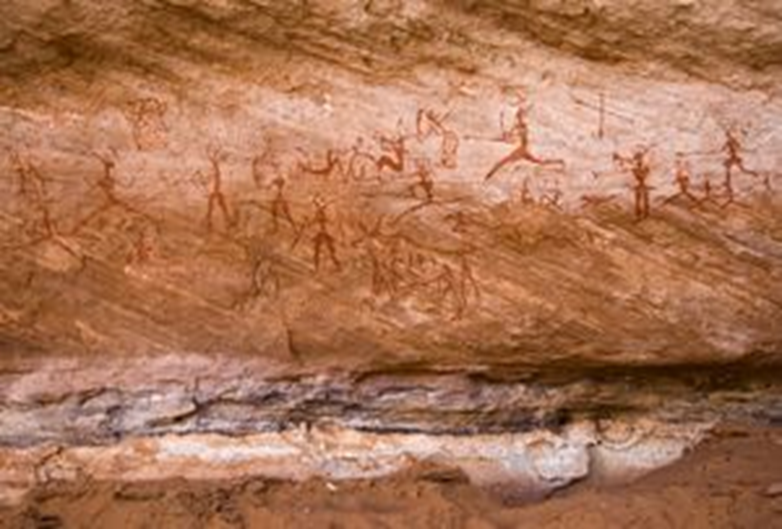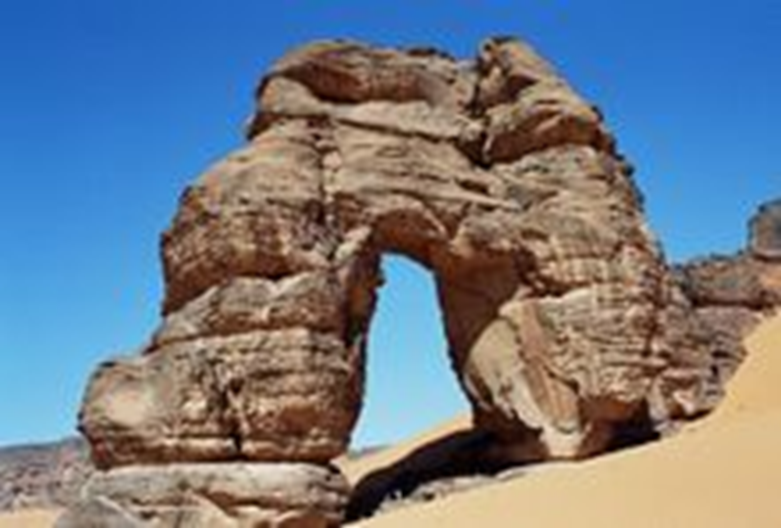Treasures of the Akakus Mountains

A rock drawing depicting giraffes and other animals in what is now desert
The Akakus Mountains or Akakus Tadrart are rocky mountains located in southwestern Libya in what was known as “Fezzan” and within the Sahara Desert, and the closest city to them is the ancient city of Ghat.
Akakos has a different range of landscapes, from colorful sand winds to rock arches and huge stones to valleys. Among the most important sites in the region are the Avazagar Arch and the Tin Khalja Arch. Although the area is one of the most arid areas in the Sahara Desert, there are some plants in it, such as the Calotropis plant.

Colorful rock drawings in the Akakus Caves in Libya show animals and people, and show the dramatic change in nature in the region.
The area is famous for its ancient caves, and is also rich in a collection of rock carvings and paintings. It was declared by UNESCO as a World Heritage Site in 1985 due to the importance of these paintings and sculptures, some of which date back 21,000 years. Which reflects the culture and nature of changes in the region. The paintings and sculptures are of animals such as giraffes, elephants, ostriches, and camels, as well as a group of people and horses, and pictures of men depicting various aspects of the life of ancient humans, for example in the case of playing music and dancing.

The Akakus Mountains in western Libya are part of the Greater Massif
A hot desert climate prevails in the Fezzan region, as it is located in the heart of the Sahara Desert. Average high temperatures exceed 40 degrees Celsius during the summer for 3 months, June, July, and August, and average high temperatures remain above 20 degrees Celsius during the coldest month of the year. Winter days are very warm, sunny and dry. Average annual rainfall is only 8 mm (0.32 in), making the site one of the driest places on Earth.

The rock arch "Ten Khalja" in Tadrart Akakos
Akakos has a different range of landscapes, from colorful sand winds to rock arches and huge stones to valleys. Among the most important sites in the region are the Avazagar Arch and the Tin Khalja Arch. Although the area is one of the most arid areas in the Sahara Desert, there are some plants in it, such as plants
It contains the most important relics and remnants of the most mysterious stages and roles of the prehistoric period. The paintings and sculptures are of animals such as giraffes, elephants, ostriches, and camels, as well as a group of people, horses, and pictures of men depicting various aspects of the life of ancient humans, for example in the case of playing music and dancing.

"Mol N Ga" circle in the Tadrart region, with wavy clouds in the sky above it
Two photos of the “Mol N Ga” circus in the Tadrart region, southeastern Algeria, with wavy clouds visible above. The image on the right was cropped using the rule of thirds; The one on the left is not.
Mummified mummy
Since 1958, the date of the discovery of the mummy of Wan Muhi Jag in the Akakos Mountains in southwestern Libya is about 5,600 years old. The secret of this lies in the fact that this date precedes by about 1,500 years the time of mummification recorded in the ancient Egyptian civilization, whose beginnings date back to (2250 - 2750) BC, which prompted scientists to reconsider the previously prevailing belief that mummification on the African continent began in Egypt. And advancing a new hypothesis that suggests that its source is one of the unknown previous civilizations that arose in the region now known as Libya over a period of 20,000 years.

Mummified mummy of a 2½-year-old child, found in the Akakus Mountains, 1958.
The mummy of "Wan Mohi Jag", or the Black Mummy, was found by an Italian archaeological mission headed by Fabrizio Mori in 1958 during excavations in a small rock cave located in the "Chwent" valley in the "Acacus" mountain range, south of the Libyan city of "Ghat" near the Algerian border.
This unique mummy, now preserved in the Al-Saraya Al-Hamra Museum in the capital, Tripoli, belongs to a small, dark-skinned boy, estimated to be two and a half years old. His body was carefully wrapped in the skin of an elk. It assumed the fetal position, its entrails were removed, and it was wrapped in wild herbs for the purpose of protecting it from rot and decomposition.
Specialists stress that a careful mummification process was performed on this child, noting that there was an incision along the abdomen and chest through which all the viscera and internal organs were extracted. It is likely that organic materials were added to the corpse to protect it from rotting.
It is also noteworthy that inscriptions and drawings of various animals, representing crocodiles, giraffes, cows and sheep, were discovered 30 meters away from the place where the mummy was found.
A circular structure of rocks with a diameter of 3 meters was also discovered, which was used as a fire pit in which sacrifices were made, in addition to a nearby altar, indicating the existence of a civilization with integrated rituals.
Source: websites

